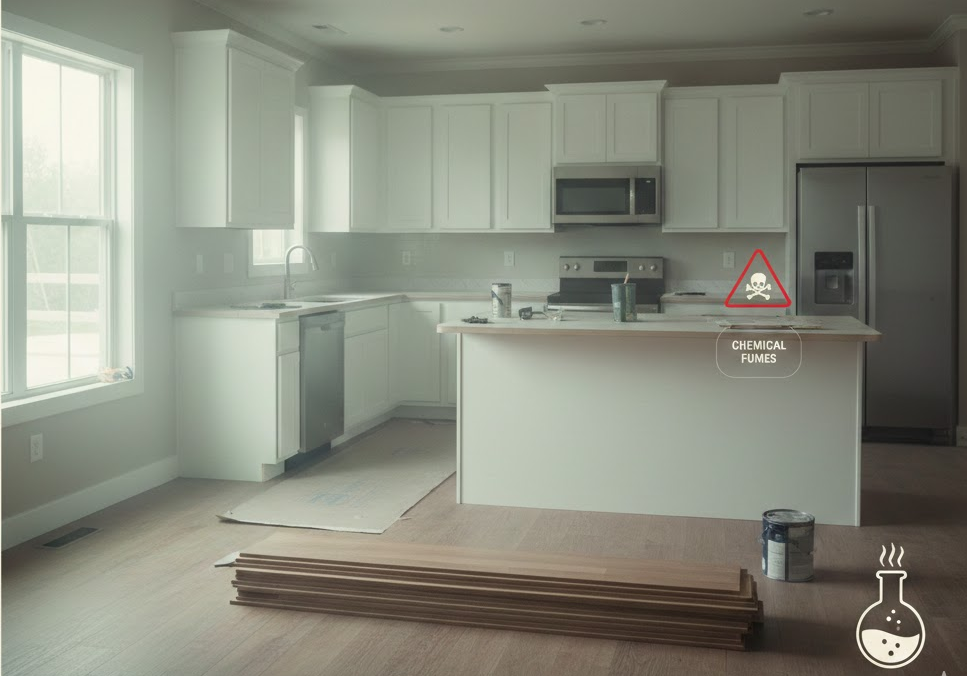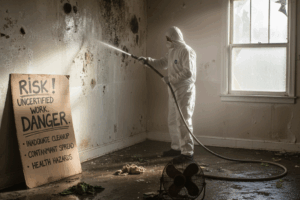
The Hidden Air Quality Risks in New Home Construction
- Categories Certifications, IAQ Industry
- Date November 27, 2025
When you walk into a brand-new home, it often smells… new. But that “new home smell” is typically a mixture of volatile organic compounds (VOCs), formaldehyde, construction dust, and even radon gas. These pollutants can compromise indoor air quality (IAQ) and lead to long-term health concerns, especially in tight, energy-efficient homes that trap indoor air.
❗ New doesn’t always mean healthy — and when it comes to air, what you can’t see can hurt you.
🔎 Why New Homes Can Have Poor Air Quality
Modern building practices favor energy efficiency and airtight seals, which are great for utility bills but bad for ventilation unless professionally managed. Here’s what often lingers in the air post-construction:
🧪 1. Off-Gassing from Building Materials
- Paints, varnishes, adhesives, cabinetry, and carpets all release VOCs
- Particleboard, plywood, and foam insulation often emit formaldehyde
- Flooring, counters, and synthetic materials contribute to lingering pollutants
🧱 2. Dust and Construction Debris in Ductwork
- Ducts installed early in the build often collect drywall dust, sawdust, and construction residue
- When the HVAC is turned on, these pollutants circulate into every room
Learn more about post-construction duct cleaning through our Certified Air Duct Cleaning Technician (CADCT) course — ideal for professionals serving builders and new homeowners.
☢️ 3. Radon Gas from Soil Intrusion
- Radon is an odorless radioactive gas that seeps in through the foundation
- New homes built over high-radon zones can exceed safe levels quickly
- Testing is not always included in standard building inspections
Certified professionals trained via our Certified Radon Investigation Technician (CRIT) program can perform radon assessments and recommend mitigation strategies before occupancy.
🩺 Health Risks of Poor Air in Brand-New Homes
While these pollutants may not cause immediate symptoms, long-term exposure can contribute to:
- Respiratory irritation, asthma triggers, and allergic reactions
- Headaches, fatigue, and cognitive fog
- Increased cancer risk from prolonged radon exposure
- Heightened sensitivity in children, seniors, and immunocompromised occupants
🛑 A healthy home starts before the keys are handed over.
🧰 How IAQCert Technicians Protect New Homeowners
Three IAQCert-certified technician roles are crucial to post-construction air quality:
🧼 Air Duct Cleaning Technician (CADCT)
Cleans, inspects, and sanitizes HVAC systems to remove construction-related particulates, allergens, and biological growth. Essential before first occupancy.
🧪 Indoor Air Quality Testing Technician (CIAQTT)
Performs comprehensive air testing for VOCs, particulates, formaldehyde, CO2, and more. Identifies hidden air quality issues using advanced tools and industry standards. See the course: CIAQTT Certification
☢️ Radon Investigation Technician (CRIT)
Conducts professional radon testing and risk assessments using both passive and active monitoring devices. Helps builders and buyers ensure safe indoor levels from the foundation up.
🏗️ Who Needs This the Most?
- Homebuyers of new builds
- Real estate agents who want to advocate for safer homes
- Home inspectors expanding into post-construction IAQ evaluations
- Builders and developers aiming for higher quality assurance
- HVAC and restoration professionals offering post-build services
🔗 Internal Links You Should Explore
- Certified Air Duct Cleaning Technician (CADCT)
- Certified Indoor Air Quality Testing Technician (CIAQTT)
- Certified Radon Investigation Technician (CRIT)
- Verify Certification
- About IAQCert
🔗 External Authority Sources
📣 Final Takeaway
Your brand-new home may look flawless—but the air inside could be compromised from day one. With proper testing, remediation, and cleaning, IAQCert-trained professionals help ensure your indoor air is as fresh as your finishes.
You may also like

IAQCert Alumni Renewal Rate — Continue Your Certification at 70% Off


